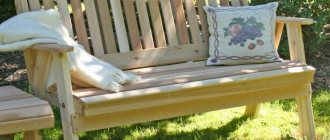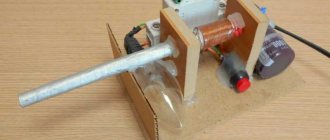“...Oh, the white ship...” Who would refuse a romantic walk along the river or a cruise on a luxury liner? The wind in your hair, fresh river or sea air... Beauty, and that’s all!!! But not everyone can afford such pleasure. How else can you diversify your summer weekend if there is a body of water in the immediate vicinity? The answer is simple: build a raft and float down the river on it. Moreover, the construction of a raft does not require any special engineering knowledge or expensive materials. It is enough to remember the basic rules and look around. There may be visible or invisible building materials around. What are we talking about? Let's explain now.
You can build a rafting raft from plastic bottles
As is already becoming clear, the building material here is ordinary plastic bottles. Their number is determined by how many people you expect to build your raft. The fewer people, the fewer bottles. But let's turn to the instructions directly. Let us immediately note that this is an option for building the simplest raft; You can always make your design fantasies come true.
How to build a raft with your own hands from plastic bottles
Adviсe:
- Firstly, plastic bottles need to be very meticulously and scrupulously examined for holes and holes. Why do this, I think, there is no need to explain.
- Secondly, screw the cap of the bottle tightly, which must be filled with air. This increases the raft's buoyancy.
Instructions:
- Using waterproof tape, we make a block of four bottles. This amount of plastic containers is optimal, because if damaged, the unit can be easily replaced.
- Wrap them with tape as tightly as possible to each other so that the raft does not fall apart. The number of blocks is again determined by the carrying capacity of the raft.
- Next, the blocks are tied into sections, which are formed along the width of the structure.
- The sections are already connected to each other to form the raft itself.
- Next we make the deck of the raft. There is no way without it; passengers with their belongings will be accommodated on it. We make the base from two wooden boards, the length of which should be equal to the length of the raft.
- We fasten the boards on top, across the first two. The distance between them is 40-50 cm. We attach some of the raft bottles to them using a rope and waterproof tape. To make it even more comfortable to be on deck, cover the bottom of the raft with plywood and place a tarpaulin on top. This will help prevent things from getting wet.
You can build a raft for children. A homemade raft that can be launched in streams or a rubber pool is very easy to make from a piece of cardboard and two plastic bottles.
Preparation of materials
To build a raft you will need empty plastic bottles. It is most convenient to work with containers of 5-6 liters. You need less of them than two-liter ones, so building a raft will take less time and effort. Among other things, you will need waterproof tape. Some structures also require bags (not linen) and boards.
Before assembling the raft, the bottles need to be processed. To make the raft look good from the outside, try to collect plastic containers of the same color, size and shape. To keep your raft afloat better, select only intact and undeformed containers. Wash all plastic containers, free them from stickers and glue residues. The plastic bottles themselves are very soft. To make them harder and denser, it is necessary to increase the air pressure in them. To do this, place the opened bottles in the freezer for a short time, then remove them and immediately close them. At room temperature, the air will gradually heat up and expand, making plastic containers harder.
How to make a raft from barrels with your own hands
Another option that is not very labor intensive is a raft made from barrels. We are, of course, not talking about iron or metal tanks, but about light plastic barrels with a volume of 200-250 liters. The barrels here will serve as an air cushion for the raft; a wooden frame will still need to be attached on top. Where can I get them? If you know auto chemical dealers, I think they will be happy to get rid of useless containers.
Barrel raft
So let's get started.
- First of all, you should seal the seams and openings of the barrels with sealant so that air does not escape from them.
- While the sealant dries, we assemble the frame from the boards. It is usually rectangular in shape, with two additional longitudinal boards closer to the edges. The distance between the edges and these boards should be equal to the diameter of the barrels.
- Our barrels will be attached to these unique “corridors”.
- Next we install the flooring on the frame.
- Then we begin to adjust the barrels. It is best to secure them with a rope, tying them tightly to the deck along the entire length of the raft.
- That's all, the raft is ready.
Deserted beach
The next day was forecast to be hot. Abnormal heat has hit the Urals!
And how wild it was for us to watch the deserted city beach that was in our sight.
The beach was the first in the region to be prepared for the season, and then closed due to the epidemic. (I will not dwell on this in detail, since I wrote about it in the article about “City Beach 2020”).
Isolated on a raft during an epidemic - an ideal place for swimming
And no prohibitions affected us. We were on our raft, moored to an uninhabited island in the shape of a heart, did not disturb anyone, did not pose a threat of infection to anyone, and with great pleasure fished, swam and sunbathed, in the reflected rays, under a canopy, on these hot July days .
How to build a raft with your own hands from wood
The wooden raft is the most popular type of watercraft from this series. Dry coniferous wood is usually used for construction. Collecting material doesn’t really contain any tricks. Cut down trees, stack logs nearby.
Wooden raft
Next comes the fun part - assembling the raft into a single structure.
- Place the logs close to each other on the shore.
- Next, place sticks or poles across, the length of the expected width of the raft.
- Then tie the logs and cross sticks together with strong ropes.
- You can also use vines or other climbing plants for this purpose.
To make it easy to control the raft, it is better to additionally make an oar or rudder, or use a long pole.
New ideas for superstructure design
The platform itself remains the same. For reliability, we painted it again on both sides. We picked up the paint that we found, mixed up all the leftovers and off we went, didn’t bother too much. The seams on the plywood were taped with a paint bandage. And they stopped there, considering that the platform was quite suitable for further use.
We decided to install the toilet on the island, thereby increasing the free space on the raft.
The tent was moved all the way to the stern, in the corner. Our canopy from the sun and rain in front of the tent was two and a half meters long and two meters wide. In total, taking into account that the tent is a house, ours measures two meters by two, just enough for our sofas to fit closely, then the total area on the raft, closed from the rain, was nine square meters out of thirteen and a half square meters of the total platform area (as I told you in the last article, we made the raft three by four and a half meters). The brazier, which served as a fire for comfort and cooking, was taken out from under the canopy and installed on a fireproof fireproof platform specially designed last year.
In addition to the cutting table, we made a mezzanine for dishes and food, as well as a small dining table, which sometimes, if necessary, was used as a stand for fishing rods.
This year we redid the U-shaped portals for attaching the canopy, table and mezzanine, making them from timber (last year, in order to save money, we made them from the trunks of small birch and aspen trees).
When all the materials for the superstructure were prepared and delivered to the shore, we began assembling the raft (as I said in the previous article, we dismantled the raft for the winter and put it in different corners, leaving only the platform itself, which was installed vertically on stands at the rear hangar walls).
What is the Kon-Tiki raft made of?
From the school history course, everyone knows about a traveler named Thor Heyerdahl, who went on a long sea voyage on a raft called Kon-Tiki, which in turn was named after the sun god of the ancient Incas.
Kon-Tiki raft
The wood from which the Kon-Tiki raft was built is called balsa. The raft was built from nine such trees. These logs served as the basis of the raft. On top, Heyerdahl laid the same number of balsa logs, but with a smaller diameter, which became the basis of the deck. And they covered the deck itself with bamboo mats, from which they also built a hut with a roof made of banana leaves. It is noteworthy that not a single nail was used to build Kon-Tiki, only ropes. The mast and rudder were constructed from mangrove wood.
0
Author of the publication
offline 3 years
Nika
18
I am interested in hiking and traveling, photography and videography. I have been going hiking since childhood. The whole family went and went - sometimes to the sea, then to the river, to the lake, to the forest. There was a time when we spent a whole month in the forest. We lived in tents and cooked over fires. This is probably why I am still drawn to the forest and, in general, to nature. I travel regularly. About three trips a year for 10-15 days and many 2 and 3 day hikes.
Comments: 0Publications: 668Registration: 10/23/2018
Nika's Shelter
Guests on the raft
A few days later, towards evening, we were expecting Vladimir to visit. This is my old school and student friend. He lives in Yekaterinburg and, having responded to our invitation to live on a raft, relax, and go fishing, he was supposed to come to us that evening.
The phone rang, but it turned out not to be Vladimir, but my other friends from my student years, the married couple Pavel and Natalya, who, it turns out, had already arrived at the pier with the aim of visiting our raft as excursionists.
Occasionally we have guests, we are glad to see them, because our raft has four times the buoyancy reserve, it will withstand any guests
I jumped on the yacht, chased after them and soon they were already on the raft. They looked at our life and being and they really liked everything. Pavel said that early in the morning he went fishing in the area of the old pioneer swimming pool and caught a lot of perch from three to six in the morning. And after six the bite stopped. And Yura and I slept through the morning bite that day and were lazy. And during the day the fish bit sluggishly. Which is what we told them about.
At this time the phone rang - Vladimir arrived.
Newbies are lucky!
I put Pavel and Natalya on the yacht and took them to the pier. There I met Vladimir and we went with him on a yacht to our uninhabited island.
When we approached the raft, the following picture appeared before us:
Yura is struggling with some big fish, trying to pull it onto the raft, but we had a landing net in the yacht and when it lifted the fish above the water (and it turned out to be bream), it jerked sharply, hit its tail against the side of the raft and... fell off the hook and that was it.
It's a shame, annoying, but okay.
Vladimir asked Yura for a fishing rod and also sat down to fish with us. And as soon as he baited the worm and cast the tackle, his float, at first, after casting, confidently rose vertically, suddenly lay down on the water, lay there for a while and sharply moved to the side. Vladimir is an inexperienced fisherman, but here he did everything right. He hooked it in time, brought the fish to the surface of the water and led it to the raft. And at that time Yura took the landing net, which we had prudently pulled out of the yacht and very deftly caught the bream with it.
Fishing on a raft is a sacred thing
So there was not a penny, but immediately an altyn. Now we had small fish for the fish and bream for the second.
This was Vladimir’s first big fish in his life.
It was already evening and we immediately cooked fish soup, fried bream and sat down at the table.
A barbecue is used to build a fire
Having refreshed ourselves, we took the guitar and passed it from hand to hand all evening, singing old student songs under the stars until we wanted to go to the side. The night was warm, mosquitoes did not bother us much and we slept carefree until the morning.
Raft with canopy
This is an almost full-fledged vessel with a canopy, which can be used for long walks on a pond, even in the rain or under the scorching sun. The structure is made according to the same principle, but additionally supports and a canopy (roof) are installed. It should be taken into account that these elements have a certain mass (50-80 kg), so such a vessel can support one less person, i.e. maximum nine passengers.
The step-by-step instructions look like this:
- Roof rafters can be made from ordinary boards, but it is better to make them bent. To do this, the still raw wood is fixed with clamps and dried in this state in the open air.
- To ensure the maximum carrying capacity of the vessel, you can use not the standard six, but 10 plastic containers of 200 l - five pieces on each side.
- You should not fix the containers right away; first you need to assemble the frame. It is secured not only with transverse but also with diagonal crossbars. Then the design will be quite reliable and will withstand even mild collisions.
- Next the floor is laid. The boards are sanded in advance and treated with an antiseptic.
- The difference between this type of raft is the presence of a canopy. For it, four supports around the perimeter are installed in advance and rafters for the roof are laid.
- All rafters are laid.
- The plywood for the roof is also bent - for this you need to use a heavy load.
- The plywood sheet is pressed with clamps, after which it is secured to the rafters using a screwdriver.
- Fastening of 200 liter barrels is carried out directly on the water, since it will not be possible to transport such a bulky structure in assembled form.
- At the last stage, the boat electric motor is installed. You can also use a walk-behind tractor, as in the option described above.
- If desired, you can even set up a small sail. It will perform not only decorative functions, but will also serve as a kind of wind engine.
How to find food
You can replenish food supplies by catching fish and birds using fishing gear that is included in the raft’s lifesaving kit. As fishing accessories, you should use the following available items: threads made of canvas (tarpaulin, nylon rope), hooks made from coins or a pocket knife, etc.
Absolutely all seabirds found far from the shore are edible and can be caught with a large fishing hook kept afloat.
A large number of fish caught far out to sea are edible, but in tropical areas poisonous representatives of the aquatic world can be found. Poisonous fish contain a large amount of poison in their meat, which cannot be neutralized even with heat treatment. Externally poisonous fish have many thorns, growths, thorns and a frightening appearance. It is not recommended to eat or handle such fish, since poison may be at the ends of their spines and thorns. Shark meat is not poisonous, but has a specific smell of ammonia, which is explained by the physiological structure of its body (Figure 4).
Figure 4. Options for obtaining food on the high seas
Algae with large stems and leaves can become an additional reserve for replenishing food supplies. Algae with small branches and the shape of threads contain substances that irritate the mucous membrane. Before using seaweed directly for food, you need to knead it in your hands. The appearance of a sharp sour odor in algae indicates their unsuitability for consumption.











